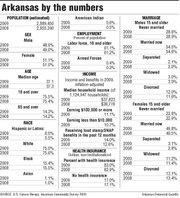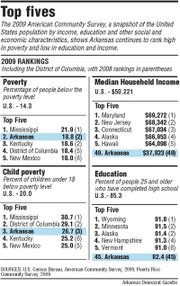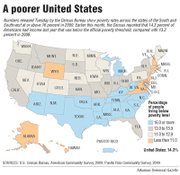LITTLE ROCK — As the recession shook Americans’ confidence last year, more than a quarter of Arkansas children - and almost one-fifth of residents - were living in poverty, new census figures show.
Arkansas ranked third in the nation with 26.9 percent of “related children” under 18 who were living in poverty in 2009, according to the Census Bureau’s American Community Survey. “Related children” are tracked through income reported by household heads.
The percentage of Arkansas children living in poverty has risen steadily since 2006, when it was 23.8 percent, the census data show.
Mississippi led the nation with 30.7 percent of children living in poverty last year; the District of Columbia was second with 29.1 percent. Nationwide, 19.7 percent of children were living in poverty.
In 2009, the cash-only poverty level was $21,954 a year for a family of four, according to government calculations that include cash income before tax de-ductions. The level doesn’t include noncash assistance such as food stamps.
The poverty numbers were among a broad array of new census data released Tuesday that document the far-reaching impact of a business slump that experts say technically ended in June 2009: a surging demand for food stamps, considerably fewer homeowners and people doubling up in housing to save money.
The figures come weeks before the pivotal Nov. 2 congressional elections, when voters anxious about rising deficits and the slow pace of the economic recovery will decide whether to keep Democrats in power.
‘OBVIOUSLY TROUBLING’
Rich Huddleston, executive director of Arkansas Advocates for Children and Families, said the state’s child poverty numbers “were obviously troubling.”
“Children are at a point in their lives where developmentally they need access to nutritious meals, good housing, good health care - you know all the things that money can buy,” he said. “The research clearly shows that people who grow up in poverty are much more likely to be at risk of all the negative outcomes that we talk about all the time.”
Arkansas Advocates for Children and Families is a Little Rock-based nonprofit whose mission is “to ensure that all children and their families have the resources and opportunities to lead healthy and productive lives and to realize their full potential,” according to its website.
Huddleston said he expected an increase in child poverty because of the recession, but not one as severe as the more than 2 percentage-point increase shown in Tuesday’s numbers.
“What makes it especially troubling for a state like Arkansas is that our child-poverty rate was already high to begin with,” he said.
The census’s American Community Survey reported 24.5 percent of Arkansas children in poverty in 2008.
The survey relies on responses taken during the 2009 calendar year. It covers geographic areas with populations of 65,000 or more and is one of the surveys used as “the basis for allocating more than $400 billion in federal funds to state, local and tribal governments,” according to the Census Bureau. The survey provides estimates that are subject to sampling margins of error.
According to the survey, Arkansas was also one of 21 states that had an overall poverty rate above the 14.3 percent national level. The state ranked second, with 18.8 percent of residents falling below poverty level.
Mississippi had the highest with a 21.9 percent poverty rate. New Hampshire had the lowest poverty levels overall and among children.
CITES OTHER FACTORS
Michael Pakko, state economic forecaster and chief economist at the Institute for Economic Advancement at the University of Arkansas at Little Rock, said Arkansas’ poverty ranking can be misleading because it relies on a base poverty level for the entire nation, leaving out factors such as cost-of-living.
“When you’re looking at real purchasing power of the income it goes a little bit further in Arkansas, and the poverty rates don’t account for that,” Pakko said.
“I’m not trying to justify it by saying everything’s rosy. I think that our ranking tends to be exaggerated by the fact that there’s a uniform standard across the nation that doesn’t reflect those differences,” he said. “We’d fare better in state-to-state comparisons if those differences were included.”
In Arkansas, the percentage of families whose income fell below the poverty level increased from 13.2 percent to 14.8 percent, with increases in all categories of families and all age groups but one. The percentage of those 65 and older beneath the poverty level fell from 12.4 percent in 2008 to 12 percent in 2009.
The percentage of households in the state using federal food stamp assistance also rose to 14 percent in 2009, an increase of about 1.4 percentage points from 2008.
The number of U.S. households receiving food stamps surged by 2 million last year to 11.7 million, the highest level on record, meaning that one in 10 families were receiving the government aid. In all, 46 states and the District of Columbia had increases in food stamps, with the largest jumps in Nevada, Arizona, Florida and Wisconsin.
The government revealed that the income gap between the richest and poorest Americans grew last year by the largest margin ever, stark evidence of the impact the long recession starting in 2007 has had in upending lives and putting the young at greater risk.
The top-earning 20 percent of Americans - those making more than $100,000 each year - received 49.4 percent of all income generated in the U.S., compared with the 3.4 percent earned by the bottom 20 percent of wage-earners who fell below the poverty line, according to the newly released census figures. That ratio of 14.5-to-1 was an increase from 13.6 in 2008 and nearly double a low of 7.69 in 1968.
A different measure, the international Gini index, found U.S. income inequality at its highest level since the Census Bureau began tracking household income in 1967. The U.S. also has the greatest disparity among Western industrialized nations.
At the top, the wealthiest 5 percent of Americans, who earn more than $180,000, added slightly to their annual incomes last year, government data show. Families at the $50,000 median level slipped lower.
Three states - New York, Connecticut and Texas - and the District of Columbia had the largest gaps in rich and poor, disparities that exceeded the national average. Similar income gaps were evident in large cities such as New York, Miami, Los Angeles, Boston and Atlanta, home to both highly paid financial and high-tech jobs as well as clusters of poorer immigrant and residents in minority groups.
On the other end of the scale, Alaska, Utah, Wyoming, Idaho and Hawaii had the smallest income gaps.
Information for this article was contributed by Hope Yen of The Associated Press.
Front Section, Pages 1 on 09/29/2010


